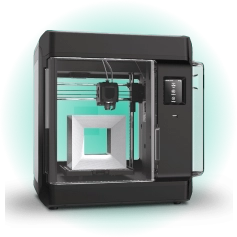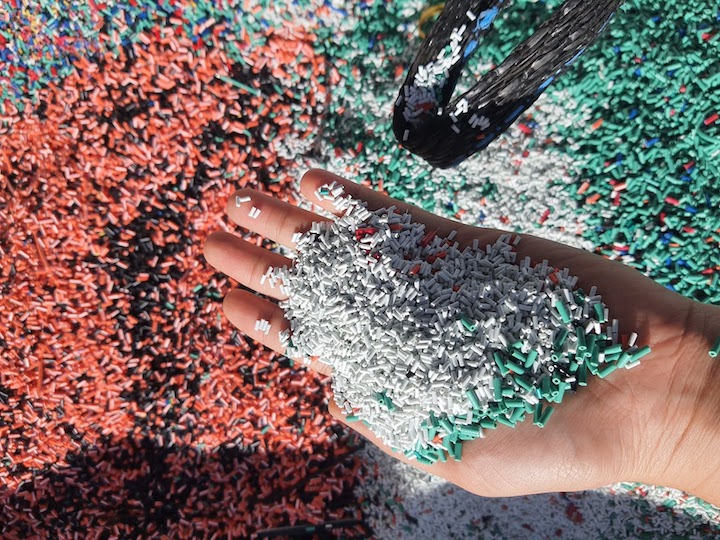Time to read: 9 min
Compression molding vs. injection molding is a contest between two of the most popular ways to mold plastic and rubber parts. Each process has advantages and applications, but what’s the best choice for your next project? To answer that question, you’ll need to understand how each process works and where they differ.
The main difference between compression molding and injection molding involves the way that plastic or rubber enters the mold. Compression molding places a pre-measured amount of material into a mold, which is then closed and heated under pressure. With injection molding, the material is heated and injected into a closed mold cavity under high pressure instead.
These differences are important, but they don’t tell the full story of compression vs. injection molding. For example, compression molding has lower tooling costs but longer cycle times. That makes it a good choice for lower part volumes, but low-volume injection molding is also an option – if you have the right partner.
When comparing compression molding and injection molding, consider the following:
- Part Design
- Mold Design and Tooling Costs
- Molding Materials
- Processing, Part Volumes, and Applications
Keep reading to learn more. Then, when it’s time to start your project, create a free Fictiv account and upload your part drawing. Whether you need compression molding or injection molding, we have what you need.
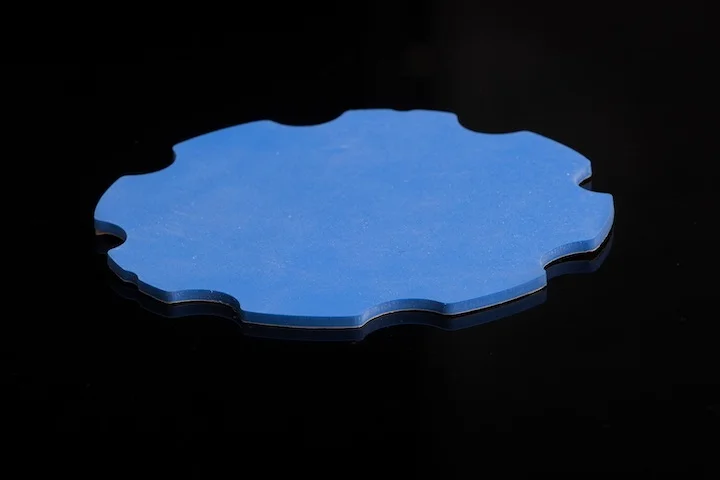
Part Design
When comparing compression molding vs. injection molding, consider part size, part tolerance, part complexity, design rules, and surface finish. Otherwise, a part designed incorrectly or for the wrong process can result in molding defects like warpage and shrinkage.
Part Sizes
Compression molding can produce larger and heavier parts than injection molding. Still, that doesn’t mean designers can’t use injection molding for parts like automotive dashboards. Plus, both molding processes can produce smaller parts as well. Examples include the facepieces for respirators and CPAP machines.
Part Tolerances
Compression molding can’t match injection molding’s part tolerances, but compression-molded components still have good dimensional accuracy. Compression-molded parts can also include features, such as threads, that support product assembly. With both molding processes, designers who use tolerance stack-ups can demonstrate how parts fit together.
Part Complexity
Compression molding is used with flat parts, thin-walled parts, and components with relatively smooth contours and simple geometries. It’s not a good choice for parts with sharp edges, steep angles, or intricate details. For complex parts, injection molding is a better choice instead. Examples include the intricate enclosure components that Lampix needed for an AR projector.
Design Rules
Because injection molding supports more detailed designs, its design rules are both more numerous and complex. With both molding processes, however, it’s essential to avoid excessively thick walls, unnecessary undercuts, sharp corners, and sudden changes in wall thickness. This helps to minimize the risk of defects while also controlling costs.
For information about injection molding part design, download this free e-book for reference.
Download Fictiv’s Injection Molding Design Guide
Surface Finish
Injection-molded parts and compression-molded parts can both have a smooth surface finish. Designers can also specify a polished, glossy, or textured part finish instead. This desired finish is applied toward the end of the mold-making process and then during molding, is transferred from the mold to the surface of the parts.
Mold polishing or texturing adds complexity, however, which can undercut some of the main advantages of compression molding: simpler mold designs and lower tooling costs.
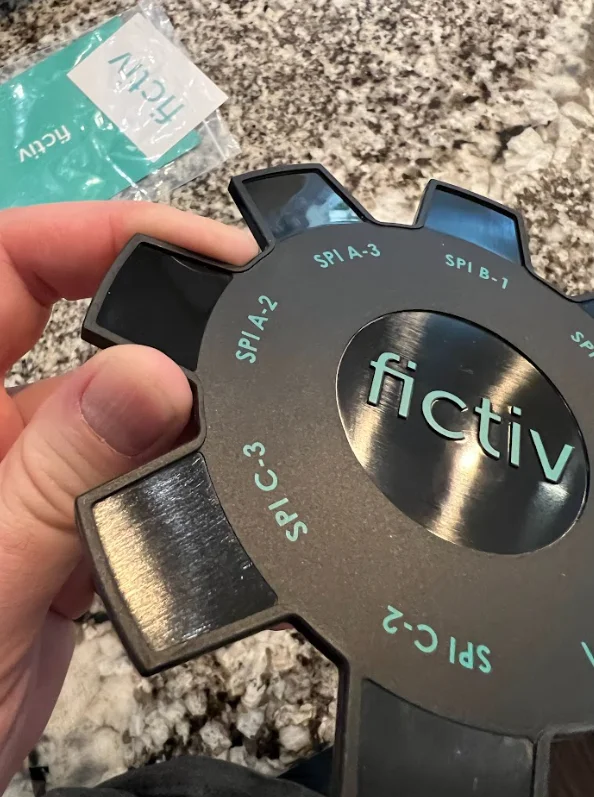
Fictiv’s Injection Molding Sample puts surface finishes and textures in your hands.
Mold Design and Tooling Costs
The molds, or tools, used with compression molding and injection molding have some things in common but also some important differences.
Mold Cavity, Core, and Parting Line
Compression molds and injection molds both have a cavity, a core, and a parting line.
- The cavity is filled with plastic or rubber and forms the part’s external surfaces.
- The core is the inverse of the cavity and forms the part’s internal surfaces.
- The parting line is where the core and cavity meet. It’s also where excess material called flash can escape.
There are some differences between molding processes, however. With compression molding, the core is the stationary top half of the mold and the cavity is the moveable bottom half. With injection molding, the core is usually (but not always) movable. In most injection molds, the core moves away from the cavity, which is stationary, and holds the part until it’s ejected.
Single Cavity Molds vs. Multi-Cavity Molds
Compression molds and injection molds can have one or more cavities.
- Single cavity molds cost less but can produce only one part per cycle.
- Multi-cavity molds are more expensive but can produce multiple, identical parts in a single cycle.
Injection molding also supports the use of family molds. These tools have multiple cavities, but they produce different parts in a single cycle. For example, an injection molder can use a family mold to produce the left and right panels for a two-part enclosure.
Mold Materials and Mold Making
Steel and aluminum are the most commonly used materials of construction for compression molds and injection molds. Both metals come in various types or grades. For example, compression molds can be made of soft, semi-hardened, or hardened steels. Grades of aluminum can be used instead, but aluminum can’t match steel for tighter part tolerances or tooling life.
Typically, CNC machining transforms a block of metal into mold plates. Compression molds can be die cast instead, but the dies still require CNC machining. Most injection molds are produced with CNC machining. They can be produced with electrical discharge machining (EDM) as well, or with a combination of CNC machining and EDM.
Mold Costs and Part Ejection Mechanisms
Compression molds are less expensive because they’re simpler and require less machining. Plus, they may not require release mechanisms since compression-molded parts can be removed from the tool by hand. By contrast, injection molds require metal ejector pins.
Injection molds may also need sliders, lifters, or hand loads to release parts with undercuts. Compression molds can use sliders, too, but most compression-molded parts are simple enough not to require them. Adding ejection mechanisms to a tool increases costs, which undercuts one of compression molding’s main advantages over injection molding.
Types of Compression Molds
There are three main types of compression molds: flash, positive, and semi-positive. The differences between them involve the amount of material that’s used and the amount of flash that’s produced. In general, compression molding produces more flash than injection molding.
Flash Compression Molds
Flash molds are the simplest, least expensive, and most popular compression molds. Because flash escapes between the parting line, however, these tools are often used with less expensive materials.
Positive Compression Molds
Positive molds cost more than flash molds but require careful measurement of the material. Typically, they’re used with deep draw parts and when it’s important to control part density. Because positive molds produce less flash, they’re a good choice for more expensive materials.
Semi-Positive Compression Molds
Semi-positive molds combine the advantages of flash and positive molds; however, they’re also the most expensive type of compression mold. Semi-positive molds do not require precise material measurements, but it’s still important to minimize flash to limit post-processing.
Types of Injection Molds
Injection molds vary by mold runner system.
- Hot runner mold systems consist of heated plates with a manifold system.
- Cold runner mold systems contain an unheated channel that conveys molten plastic into a mold cavity.
- Insulated mold runner systems resemble traditional cold runners, but incorporate heating methods to create a surrounding layer of molten resin.
Injection molds can also be categorized by the number of plates.
Two-Plate Injection Molds
Two-plate molds are the most common and cost-effective type of injection mold. They have a single parting line where the core and cavity plates meet. These injection molds are especially efficient when they have multiple cavities, and they work well with any type of runner system.
Three-Plate Injection Molds
Three-plate molds have a third plate called the stripper plate that’s placed between the core and the cavity. Including this third plate adds costs and means the mold has two parting lines. Because the stripper plate separates the runner system from the molded part, it helps speed production. Three-plate injection molds are used only with cold runner systems.
Stack Injection Molds
Stack injection molds consist of multiple parallel mold plates that are “stacked” together to create multiple faces or levels for injection molding. They have higher up-front costs but require less clamping tonnage per cycle. These injection molds can accommodate various materials simultaneously for greater flexibility in production.
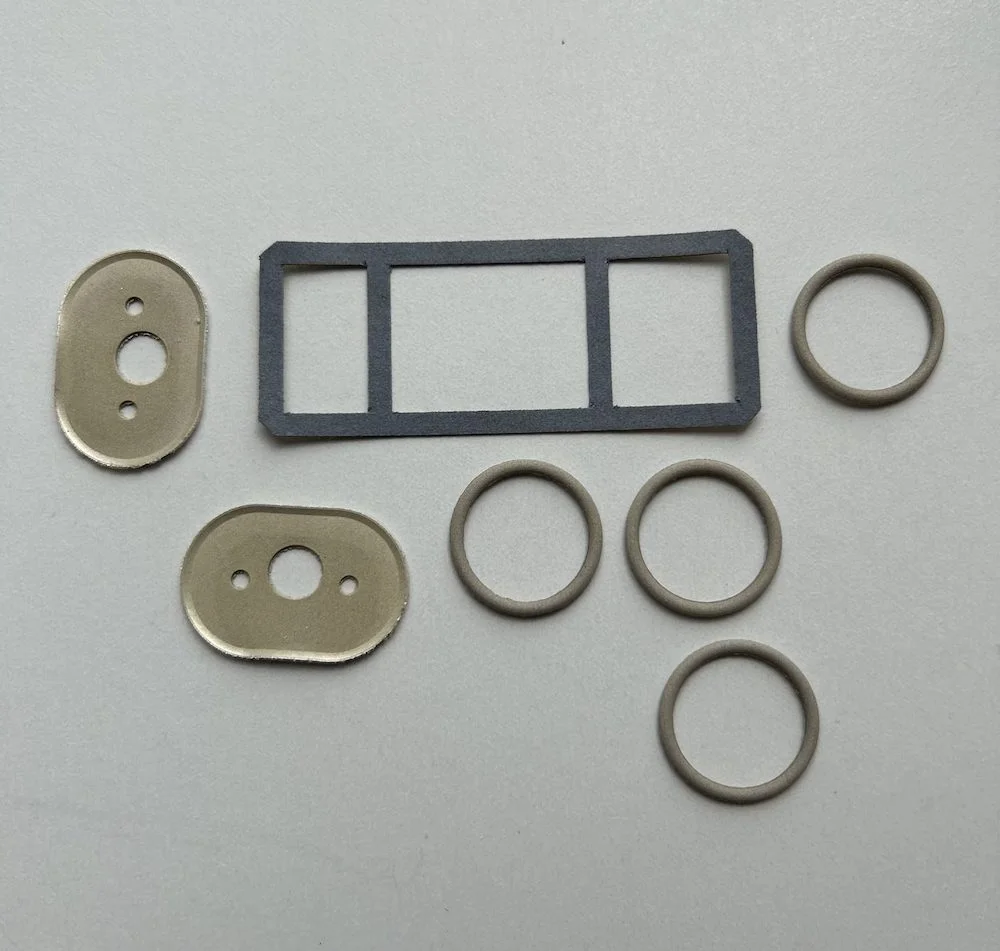
Compression molding produced these gaskets and O-rings. (SSP)
Molding Materials
When comparing compression molding vs. injection molding, determine whether the molding process you want to use can support the molding material you plan to select. There are many types of molding materials, but they can be divided into plastic, rubber, and composites.
Thermoplastics vs. Thermosetting Polymers
Compression molding and injection molding can process many of the same thermoplastic resins. In addition, both processes support the use of commodity plastics and specialty plastics and polymer blends. Examples of these thermoplastics include:
- Nylon
- Glass-filled nylon
- Polypropylene
- Polyester
- High-density polyethylene
- PEEK
Compression molding also supports the use of thermosets, polymers that can be liquefied once but have better mechanical properties than thermoplastics. Although some injection molding machines support thermosets, most do not. That’s because thermoset injection molding requires special screws and barrels for the injector unit.
Examples of compression-molded thermosets include:
- Phenolic resins
- Epoxy
- DAP
Rubber Molding Materials
Compression molding and injection molding can process some of the same elastomers, including silicone and fluorosilicone. It’s important to note, however, that compression molding uses gum-like high-consistency rubber (HCR) while injection molding uses liquid silicone rubber (LSR) instead.
Other types of injection-molded and compression-molded rubber include:
- Nitrile
- SBR
- EPDM
- Viton®
Composite Materials
Some composite materials are highly resistant to flow, and that makes compression molding the right choice since the material doesn’t have to flow through a series of channels. Examples include electrically-conductive silicones and fluorosilicones that contain metal, metal-coated, or bimetallic particles.
Bulk molding compound (BMC) is a thermoset composite that’s used only with compression molding. It has a dough-like consistency and is a combination of polymer resins, chopper fibers, and a hardening agent. Sheet molding compound (SMC), a polyester reinforced with glass fibers, is also compression molded because of its consistency.
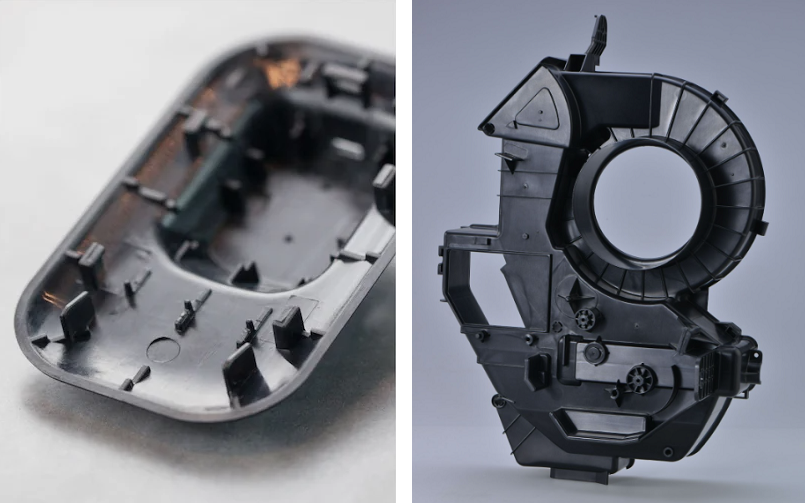
Injection molding is a better choice for complex parts like these.
Processing, Part Volumes, and Applications
Compression molding and injection molding both use heat and pressure to produce parts. More specifically, the molding material is heated so that it flows and fills the mold cavity. Pressure is applied to the tool to hold the mold shut. After the part cools, it’s released from the mold and may require post-processing.
Compression Molding Press vs. Injection Molding Machine
A compression molding press is a simpler piece of equipment than an injection molding machine. Loading a compression mold is a manual process, and an operator must physically close the tool. By contrast, modern injection molding machines are highly automated. Even the hopper where resin is loaded may be programmable.
Pressure and Heat
During plastic injection molding, injection pressures can reach 30,000 to 40,000 pounds per square inch (psi). The clamping pressure is even higher so the mold won’t open while plastic is injected. Compression molding is performed at lower clamping pressures and some compression molds aren’t pre-heated. By contrast, injection molds require preheating to improve part quality. Cooling systems may also be part of the injection mold.
Cycle Time and Production Volume Considerations
Injection molding has significantly shorter cycle times than compression molding. That makes it a better choice for higher part volumes, but low-volume injection molding can be used for projects ranging from 100 to 10,000 pieces. Below 100 parts, designers may want to use compression molding instead – but 3D printing or even urethane casting are also options.
For compression-molded parts where cycle times are a concern, multi-cavity molds can help speed parts production. Post-processing is also a factor. Because injection molding is performed at higher clamping pressures, there’s usually less flash. For both molding processes, however, either manual trimming or cryogenic deflashing can be used.
Overmolding and Insert Molding
Compression molding and injection molding both support overmolding and insert molding, processes that eliminate post-molding part assembly.
- Overmolding molds a part from one material and then molds another material over this part. For example, a softer grip can be molded over a harder handle.
- Insert molding molds a material over a prefabricated component. For example, a rubber or plastic handle can be molded over a metal knife blade.
Generally, part complexity and part volumes determine which molding process is used.
Industrial Applications
Compression molding and injection molding are both used in a variety of industrial applications. Examples include aerospace, automotive, and electronics. These molding techniques are also used in consumer products and medical and dental applications. Although injection molding is better for high volumes of parts, compression molding can support personalized applications such as dentures because of its lower tooling costs.
Compression Molding vs. Injection Molding: The Right Choice
Compression molding and injection molding are plastics manufacturing processes that each have advantages. No matter what you decide, you’ll make the right choice when you partner with Fictiv. Along with your request for a quote, you’ll receive design for manufacturability (DFM) feedback that can help you avoid defects and reduce troubleshooting. Fictiv works with a carefully vetted network of global partners, so why look for a molder on your own?
Is it time to get started? Create a free Fictiv account and upload your part drawing.








